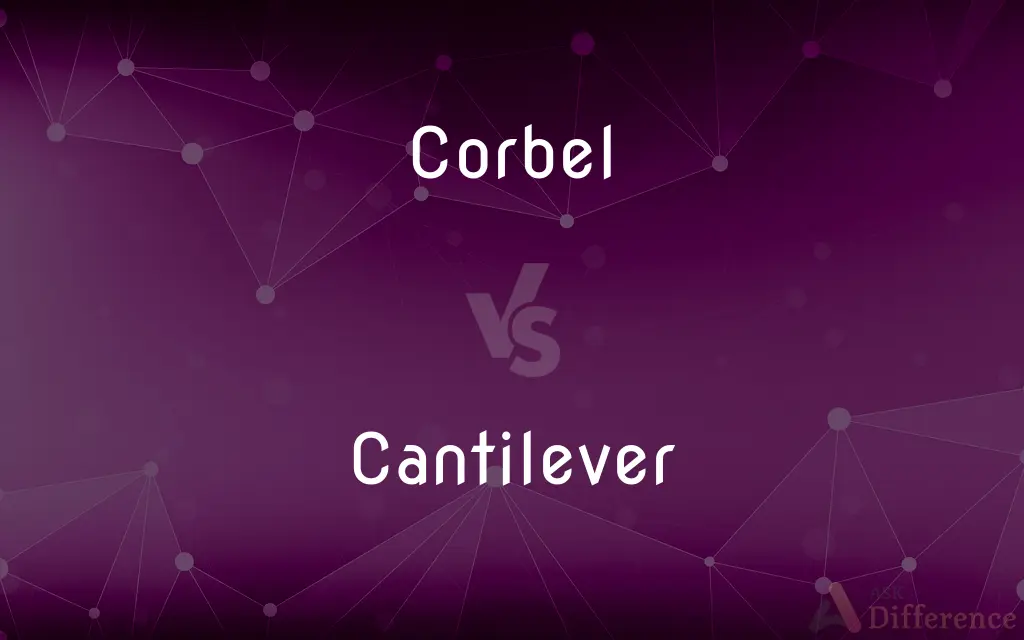Corbel vs. Cantilever — What's the Difference?
By Tayyaba Rehman & Maham Liaqat — Updated on April 2, 2024
Corbel uses stacked elements for support, resembling steps; Cantilever extends from a single point with no support at the other end.

Difference Between Corbel and Cantilever
Table of Contents
ADVERTISEMENT
Key Differences
Corbel and cantilever are both architectural terms describing elements that project from a wall, but they differ significantly in structure and engineering. A corbel is an architectural feature where successive layers of material are extended slightly beyond the one below, creating a stepped appearance. This method has been used since ancient times for supporting projections or overhangs. In contrast, a cantilever is a structural element that extends horizontally and is supported at only one end, with the other end projecting into space without any external bracing.
Corbelling creates a form of support that distributes weight back into the wall or structure from which it projects. This technique allows for the creation of balconies, beams, and arches using materials like stone, brick, or wood, building up layers to achieve the desired projection. Cantilevered structures, however, rely on the strength of the material and the integrity of the support at the single point of connection. Modern examples include large balconies, bridges, and even buildings where part of the structure extends into open space, supported without visible means at its far end.
The design and aesthetic of corbelled elements often contribute to the architectural style and detail of a building, adding decorative as well as functional features. Cantilevers, meanwhile, are celebrated for their engineering and the dramatic visual effect they create, seemingly defying gravity. They are particularly prominent in modern architecture, where the use of steel and reinforced concrete has enabled more ambitious cantilevered designs.
In terms of structural engineering, corbels distribute loads vertically and require careful construction to ensure stability and weight distribution. Cantilevered structures, on the other hand, must account for torsion, bending, and shear forces, requiring detailed analysis to prevent failure. The use of cantilevers is often a showcase of engineering prowess, highlighting the balance between form and function.
The choice between corbelling and cantilevering depends on the architectural requirements, aesthetic goals, and structural considerations of a project. While corbelling is suited to traditional or historical reproductions, requiring minimal extensions and using specific materials, cantilevering offers a modern approach with greater flexibility in design and the potential for significant horizontal extension.
ADVERTISEMENT
Comparison Chart
Definition
An architectural feature where elements are stacked in a stepped-out manner.
A structural element that extends horizontally and is supported at only one end.
Appearance
Stepped appearance, creating a tiered effect.
Projects into space with no visible support at the extending end.
Engineering
Distributes loads vertically back into the structure.
Relies on the strength of the material and structural integrity at the base.
Common Uses
Supports for balconies, beams, arches.
Used in balconies, bridges, large overhangs.
Architectural Style
Often seen in traditional architecture.
Associated with modern and contemporary architecture.
Compare with Definitions
Corbel
Effective in distributing the weight vertically.
Corbelling in the castle’s walls allowed for the creation of protruding battlements.
Cantilever
Showcases modern engineering and architectural innovation.
The cantilevered balcony provided stunning views without obstructing columns.
Corbel
Adds architectural detail while providing support.
Wooden corbels under the eaves added both support and aesthetic appeal to the cottage.
Cantilever
Characterized by support from one end only.
The bridge’s cantilever design allowed for a long span without intermediate supports.
Corbel
Used historically for structural and decorative purposes.
The ancient temple featured corbel arches, adding to its grandeur.
Cantilever
Allows for creative architectural expressions.
The museum’s cantilevered sections created dynamic, overlapping spaces for exhibits.
Corbel
Involves stacking materials in a stepped manner.
The fireplace mantle was supported by intricately carved stone corbels.
Cantilever
Contributes to a building’s modern aesthetic.
The cantilevered roof overhang gave the house a distinctive, modern silhouette.
Corbel
Common in reproducing historical architectural styles.
The new building incorporated corbels to mimic medieval architecture.
Cantilever
Requires managing complex forces.
Engineers meticulously calculated the cantilevered awning’s design to ensure stability.
Corbel
In architecture, a corbel is a structural piece of stone, wood or metal jutting from a wall to carry a superincumbent weight, a type of bracket. A corbel is a solid piece of material in the wall, whereas a console is a piece applied to the structure.
Cantilever
A cantilever is a rigid structural element that extends horizontally and is supported at only one end. Typically it extends from a flat vertical surface such as a wall, to which it must be firmly attached.
Corbel
A piece of stone, wood, brick, or other building material, projecting from the face of a wall and generally used to support a cornice or arch.
Cantilever
A projecting structure, such as a beam, that is supported at one end and carries a load at the other end or along its length.
Corbel
To provide with or support by a corbel or corbels.
Cantilever
A member, such as a beam, that projects beyond a fulcrum and is supported by a balancing member or a downward force behind the fulcrum.
Corbel
(architectural element) A structural member jutting out of a wall to carry a superincumbent weight.
Cantilever
A bracket or block supporting a balcony or cornice.
Corbel
(transitive) To furnish with a corbel or corbels; to support by a corbel; to make in the form of a corbel.
Cantilever
To construct as or in the manner of a cantilever.
Corbel
A bracket supporting a superincumbent object, or receiving the spring of an arch. Corbels were employed largely in Gothic architecture.
Cantilever
To extend outward as or in the manner of a cantilever.
Corbel
To furnish with a corbel or corbels; to support by a corbel; to make in the form of a corbel.
Cantilever
(architecture) A beam anchored at one end and projecting into space, such as a long bracket projecting from a wall to support a balcony.
Corbel
(architecture) a triangular bracket of brick or stone (usually of slight extent)
Cantilever
A beam anchored at one end and used as a lever within a microelectromechanical system.
Corbel
Furnish with a corbel
Cantilever
(figure skating) A technique, similar to the spread eagle, in which the skater travels along a deep edge with knees bent and bends their back backwards, parallel to the ice.
Cantilever
To project (something) in the manner of or by means of a cantilever.
Cantilever
Same as Cantalever.
Cantilever
Projecting horizontal beam fixed at one end only
Cantilever
Project as a cantilever
Cantilever
Construct with girders and beams such that only one end is fixed;
Frank Lloyd Wright liked to cantilever his buildings
Common Curiosities
Is one method stronger than the other?
Strength depends more on the specific design and materials than on the method itself. Each has different engineering considerations and applications.
What distinguishes a corbel from a cantilever?
A corbel uses a stepped, stacked method for support, while a cantilever extends from a single point without support at the other end.
Can both corbels and cantilevers be used decoratively?
Yes, both can have decorative purposes, but corbels are more traditionally decorative, whereas cantilevers are often used for their dramatic modern appearance.
Are cantilevers a modern invention?
While the concept predates modern times, the widespread architectural use of cantilevers, especially in ambitious designs, is facilitated by modern materials and engineering.
Can corbels support as much weight as cantilevers?
Corbels are suited for smaller, vertical extensions and load distribution; cantilevers can support significant weight but require careful engineering to do so.
Can the use of corbels or cantilevers affect a building's overall design?
Absolutely, each contributes significantly to both the functionality and aesthetic of a structure, influencing its overall architectural style.
How do cantilevers manage without support at one end?
Cantilevers are designed to transfer load to their support point through the material's strength and the structural design.
Why choose a corbel over a cantilever, or vice versa?
The choice depends on aesthetic goals, structural requirements, and historical context of the project.
Are there limitations to using cantilevers in construction?
Yes, limitations include the need for strong materials, precise engineering, and considerations of torsional forces and shear stress.
What materials are commonly used for corbels and cantilevers?
Corbels can be made from stone, brick, or wood, while cantilevers often use steel or reinforced concrete for their strength.
Share Your Discovery

Previous Comparison
Dacron vs. Cotton
Next Comparison
Putto vs. CupidAuthor Spotlight
Written by
Tayyaba RehmanTayyaba Rehman is a distinguished writer, currently serving as a primary contributor to askdifference.com. As a researcher in semantics and etymology, Tayyaba's passion for the complexity of languages and their distinctions has found a perfect home on the platform. Tayyaba delves into the intricacies of language, distinguishing between commonly confused words and phrases, thereby providing clarity for readers worldwide.
Co-written by
Maham Liaqat














































